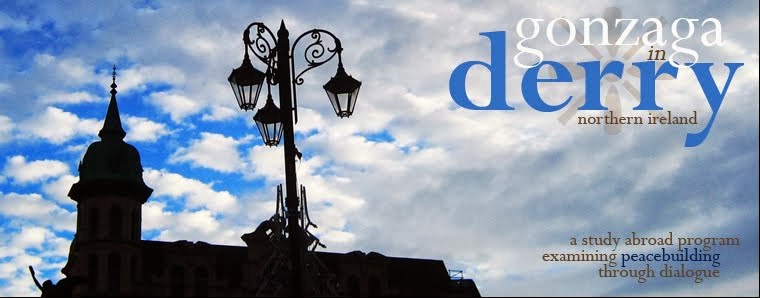
by Stephen Miller
 Walls are used in many ways over the years. They can be built for isolation, formation, and protection. Although in West Belfast, a “peace” wall stands tall as a method of division between the Nationalist Catholic and the Loyalist Protestant communities. Sectarianism, the deep-felt discrimination that prevailed during the troubles, built the shadowing wall. Robust iron gates stringently allow for transportation between the two communities. Each morning at 7:00 a.m. the heavy gates creak open permitting foot and vehicle traffic until 7:00 p.m. when gate doors clang shut. The communities don’t associate with each other; their lives don’t intermingle. “Our children don’t play together, go to school together, or befriend each other,” stated one loyalist man in West Belfast. Without interaction relationship building does not take place, and peace building progresses slowly. The tension within West Belfast could be felt in the air.
Walls are used in many ways over the years. They can be built for isolation, formation, and protection. Although in West Belfast, a “peace” wall stands tall as a method of division between the Nationalist Catholic and the Loyalist Protestant communities. Sectarianism, the deep-felt discrimination that prevailed during the troubles, built the shadowing wall. Robust iron gates stringently allow for transportation between the two communities. Each morning at 7:00 a.m. the heavy gates creak open permitting foot and vehicle traffic until 7:00 p.m. when gate doors clang shut. The communities don’t associate with each other; their lives don’t intermingle. “Our children don’t play together, go to school together, or befriend each other,” stated one loyalist man in West Belfast. Without interaction relationship building does not take place, and peace building progresses slowly. The tension within West Belfast could be felt in the air. 
In my time in Belfast I discovered that the city is divide. In many ways it seemed like two unique cultures. While a towering wall looms over the west side, the Belfast city centre teemed with busyness, shopping and dining, sightseeing, and a unique blend of people. Men, women, and children collectively gathered to enjoy their city’s culture. In the Belfast city centre life abounded. This is optimistic hope to the future of West Belfast and entirety of Northern Ireland’s peace process. Political and religious differences seemed unimportant to the enjoyment, commerce, and quality of life available in the centre. In the midst of vibrant liveliness differences aren’t divisive.

No comments:
Post a Comment